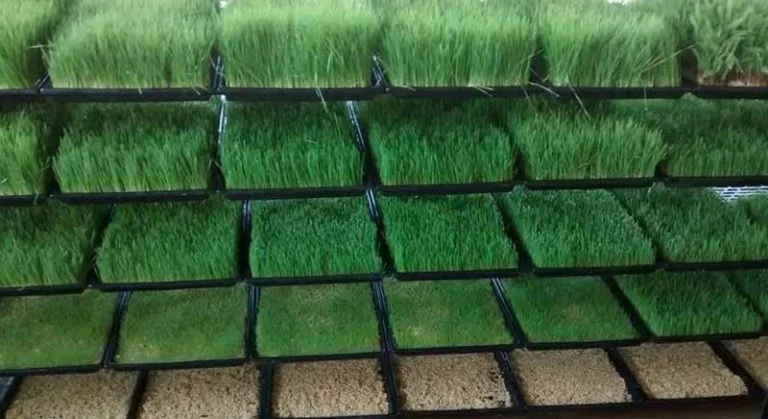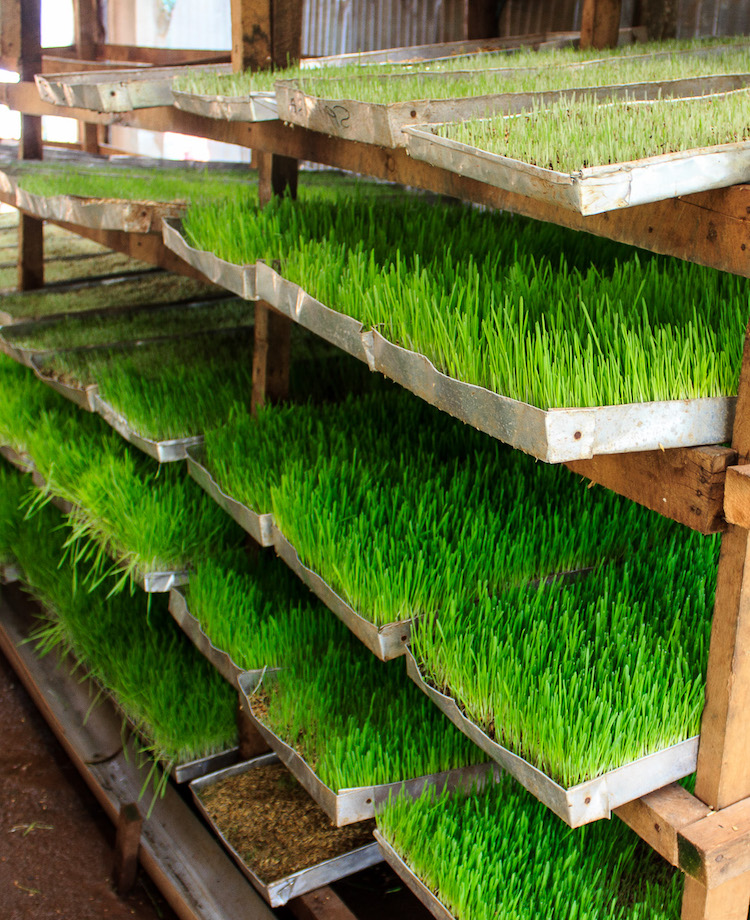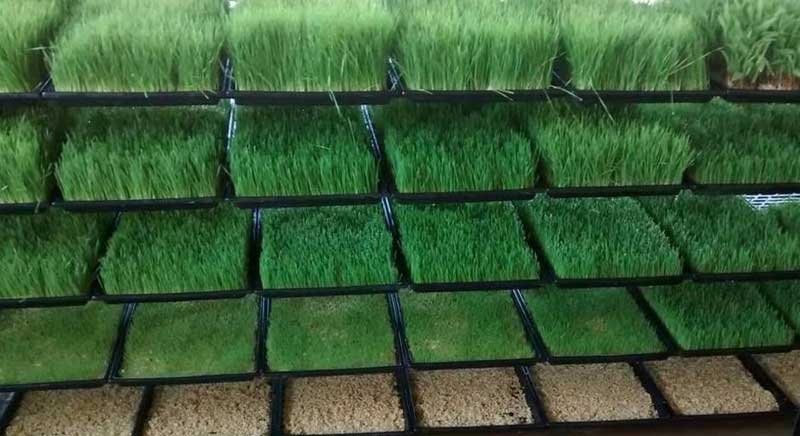Hydroponics fodder is a method to grow animal feed without soil. This technique uses water and nutrients to produce fresh fodder quickly.
In recent years, hydroponics fodder has gained popularity among farmers and livestock owners. It offers a sustainable solution to feed animals even in challenging climates. Traditional fodder cultivation needs land and water, which can be scarce. Hydroponics, in contrast, allows for efficient use of resources.
It grows fodder indoors, using controlled environments. Farmers can produce fresh, nutritious feed in a matter of days. This method reduces reliance on weather conditions and soil quality. By providing consistent feed, it supports healthier livestock. Hydroponics fodder is an innovative approach, promising to transform animal agriculture. Dive deeper to explore its benefits and impact on farming practices.

Credit: www.youtube.com
Introduction To Hydroponics Fodder
Hydroponics fodder is an innovative method of growing animal feed without soil. This system uses water, nutrients, and controlled environments to produce fresh, nutrient-rich fodder. Farmers and livestock owners are exploring this technique for its efficiency and environmental benefits. Understanding hydroponics fodder can transform livestock nutrition and farming practices.
Concept And Benefits
Hydroponics fodder involves growing plants in water with added nutrients. This system eliminates the need for soil, reducing land use and erosion. It allows controlled conditions, ensuring optimal growth and quality. The benefits are numerous. Faster growth cycles lead to consistent fodder supply. Less water usage helps conserve resources. No pesticides mean healthier feed for animals.
Importance In Livestock Nutrition
Livestock need balanced nutrition for health and productivity. Hydroponics fodder is rich in essential nutrients, vitamins, and minerals. It improves digestion and boosts immunity in animals. This fodder can enhance milk production in dairy cattle. It supports better weight gain in beef cattle. The nutritional profile is consistent, unlike traditional methods.

Credit: agricultureguruji.com
How Hydroponics Fodder Works
Hydroponics fodder grows without soil, using water and nutrients. Seeds sprout in trays, producing fresh, green feed. Livestock benefit from this nutritious and easily digestible fodder.
Hydroponics fodder is rapidly gaining popularity among farmers and animal enthusiasts. It offers a fresh, nutrient-rich alternative to traditional animal feed. But how does this fascinating process work? Understanding the mechanics of hydroponics fodder can inspire you to consider it for your own farming or gardening endeavors.Growth Process
The growth process of hydroponics fodder is a marvel of nature and technology. Seeds are sprouted in a controlled environment without soil. Instead, they are nourished with water and essential nutrients. In my experience, watching seeds transform into lush green fodder in just a few days is both rewarding and educational. It’s like having a front-row seat to nature’s magic show. You might wonder, how can something so simple yield such impressive results? The secret lies in the careful regulation of water, light, and temperature. These elements create an optimal environment for seed growth. When done right, the process is efficient and sustainable.Essential Equipment
To start growing hydroponics fodder, you need some basic equipment. A shelving unit or tray system is essential for organizing and maximizing space. You’ll also need a water supply system to keep the seeds adequately hydrated. Lighting is another critical component. LED or fluorescent lights are commonly used to simulate sunlight. They ensure that your fodder receives enough light to grow healthy and strong. Lastly, a timer for the lights and watering system can save you time and effort. It automates the process, ensuring consistent growth conditions. Having reliable equipment makes the process less daunting and more enjoyable. Have you thought about how incorporating hydroponics fodder could benefit your own farming practices? The initial setup might seem challenging, but the rewards are worth it. Plus, it’s a great way to reduce waste and contribute to a more sustainable future.Nutritional Advantages
Hydroponics fodder offers numerous nutritional benefits for livestock. This feeding method boosts animal health. It enhances growth and productivity. Animals receive a balanced diet. They thrive better with this advanced feeding technique. Let’s explore its key nutritional advantages.
Enhanced Nutrient Content
Hydroponics fodder is rich in essential nutrients. It contains vitamins, minerals, and proteins. These nutrients are vital for animal health. They support growth and immunity. Traditional fodder lacks these nutrients. Hydroponics fodder fills this gap effectively.
Fodder grown hydroponically has a higher water content. This aids in nutrient absorption. Animals consume more nutrients. They benefit from the concentrated nutrition in each bite. The result is healthier, stronger animals.
Digestibility Benefits
Hydroponics fodder is easy to digest. Its tender structure aids digestion. Animals face fewer digestive issues. This means less stress on their systems. The nutrients are quickly absorbed. This improves overall health and energy levels.
Digestibility reduces feed waste. Animals utilize more of the fodder. Farmers save on feeding costs. They see increased efficiency in livestock nutrition. This benefit makes hydroponics fodder a smart choice for any farm.

Credit: www.hydroponicsafrica.org
Setting Up A Hydroponics System
Building a hydroponics system for fodder involves arranging trays, water reservoirs, and nutrient solutions. Seeds sprout efficiently, growing without soil, ideal for consistent fodder production. This method saves space and water, offering an eco-friendly solution for livestock feed.
Setting up a hydroponics system for fodder is an exciting venture. It allows you to grow fresh, nutritious feed for livestock with minimal resources. This method requires less water and space than traditional farming. Before you start, understand the basics. This will help you create an efficient system. Let’s explore the essentials of setting up your own hydroponics system for fodder.Space And Infrastructure Needs
Choose a location with adequate space for your hydroponics setup. Ensure good ventilation and access to water and electricity. Natural light is helpful, but not necessary. Consider using artificial lights if needed. The area must be clean and free from pests. Think about the size of the system you want. This will determine the space needed.Step-by-step Setup Guide
Start by selecting the right trays for germination. Choose trays with drainage holes for excess water. Next, install a water reservoir below the trays. This will collect and recycle water. Place seeds evenly in the trays. Ensure they have enough space to grow. Water the seeds regularly. Use a timer to automate watering. Install grow lights above the trays if needed. Adjust the lights to ensure even growth. Monitor the system daily. Check for proper water flow and light. Adjust as needed for optimal growth. Keep the environment clean and free of mold. This ensures healthy fodder production.Cost And Resource Efficiency
Hydroponics fodder offers a fresh approach to growing animal feed. This system excels in cost and resource efficiency. It enables farmers to produce nutritious fodder with fewer inputs. Explore how hydroponics can save costs and resources.
Cost Analysis
Hydroponics systems lower feed production expenses. Traditional farming involves high costs for land, labor, and fertilizers. Hydroponics reduces these costs significantly. It requires less land and minimal labor. No expensive fertilizers are needed. Initial setup costs may seem high, but long-term savings are substantial.
Water And Resource Savings
Water efficiency stands out in hydroponics. Traditional farming uses vast amounts of water. Hydroponics uses up to 90% less water. This conservation benefits areas with scarce water resources. Hydroponics also minimizes resource wastage. Nutrients are recycled in a closed system. This reduces the need for continuous nutrient inputs.
Impact On Livestock Health
Hydroponics fodder is emerging as a game-changer in the world of livestock farming. It offers a sustainable and efficient way to feed animals, but how does it impact their health? Understanding this can help you make informed decisions about your farming practices. The health benefits of hydroponics fodder are substantial, and they extend beyond just nutrition. Let’s delve into how this innovative method can enhance livestock health.
Growth And Productivity
Hydroponics fodder provides essential nutrients that support rapid growth in livestock. It is rich in vitamins and minerals, which promote healthy development. When animals grow well, they are more productive, leading to higher yields.
Have you noticed how your livestock thrive when fed with high-quality feed? Hydroponics fodder offers consistent quality, ensuring your animals always get the best. This consistency helps improve the overall productivity of your farm.
Investing in hydroponics fodder can be a smart move. Your animals will not only grow faster but also produce better quality milk and meat. Is your current feed meeting these standards?
Disease Resistance
Hydroponics fodder can boost immunity in livestock. With improved nutrition, animals become more resistant to diseases. This means fewer visits from the vet and lower medical expenses.
Have you ever faced a sudden outbreak of disease on your farm? Hydroponics fodder can be your first line of defense. Stronger immunity results in healthier animals and a more stable farm environment.
Consider the peace of mind that comes with knowing your livestock are less prone to illness. Wouldn’t you prefer a farming solution that supports long-term health for your animals?
The impact of hydroponics fodder on livestock health is profound. As you explore this option, think about the potential benefits for your farm. How can you implement hydroponics fodder to maximize health and productivity? The choice is yours.
Challenges And Solutions
Hydroponics fodder is a promising technique for growing animal feed. Yet, it comes with its own set of challenges. Understanding these obstacles can help farmers improve their yield. Let’s explore common issues and effective solutions in hydroponics fodder cultivation.
Common Obstacles
Many farmers face high initial setup costs for hydroponics systems. These costs can be a barrier for small-scale farmers. Besides, maintaining the right temperature and humidity is crucial. Inconsistent conditions can lead to mold growth. Another issue is the risk of waterborne diseases. These diseases can spread quickly in a hydroponic system.
Space constraints can also pose problems. Not all farmers have enough space for large-scale systems. Furthermore, technical expertise is often required to operate these systems. Lack of knowledge can hinder successful fodder production.
Effective Strategies
To overcome high setup costs, farmers can start small. Gradually expand as resources allow. Using energy-efficient systems can reduce operational costs. Monitoring and controlling environmental conditions is vital. Automated systems can help maintain stable conditions.
Regular cleaning prevents mold and diseases. This keeps the system healthy. Farmers can also use disease-resistant seeds to minimize risks. For space issues, vertical stacking can optimize use of available space. Training and workshops can enhance technical skills. This knowledge boosts confidence in managing systems.
By addressing these challenges with practical solutions, hydroponics fodder can thrive. Farmers can enjoy better yields and healthier livestock. A well-managed system leads to sustainable farming practices.
Future Of Hydroponics Fodder
The future of hydroponics fodder is promising and full of potential. As the world faces challenges in agriculture, hydroponics offers sustainable solutions. With less water and space, it provides efficient fodder production. Advances in technology make this method even more viable. Farmers and researchers are exploring new techniques every day. This innovation could transform agriculture worldwide.
Innovations And Trends
Hydroponics technology is evolving rapidly. New systems are more efficient and user-friendly. Automated systems control light, temperature, and nutrients. These systems reduce manual labor and increase productivity. LED lighting is becoming more popular. It enhances plant growth and saves energy. Vertical farming is also gaining attention. This technique uses less space and increases yield. Researchers are exploring nutrient solutions for better growth. These innovations could lead to healthier and faster-growing fodder.
Potential Expansion
Hydroponics fodder has the potential to expand globally. Urban areas could benefit from local fodder production. It reduces transportation costs and emissions. Developing countries could use hydroponics for food security. It offers reliable and sustainable production. Farmers in areas with scarce water could find this method useful. It requires less water compared to traditional farming. This expansion could support livestock farming worldwide. More research and investment could make hydroponics a staple in agriculture.
Frequently Asked Questions
What Is The Best Fodder For Hydroponics?
The best fodder for hydroponics includes barley, wheat, and oats. These grains grow efficiently and provide excellent nutrition. Ensure you use high-quality seeds for optimal results. Proper lighting and nutrient solutions enhance growth. Hydroponic fodder is sustainable and cost-effective for livestock feeding.
What Is A Hydroponic Fodder?
Hydroponic fodder is a method of growing livestock feed without soil, using water and nutrients. It involves sprouting seeds like barley or wheat in trays, producing fresh, green fodder in about a week. This system offers a sustainable and efficient way to provide nutritious feed for animals year-round.
Is Hydroponic Fodder Worth It?
Hydroponic fodder can be cost-effective and nutritious for livestock. It uses less water and space than traditional methods. Initial setup costs are higher, but long-term savings and faster growth can outweigh them. Evaluate your farm’s needs and resources to decide if it’s worth the investment.
How Do You Make Hydroponic Fodder Feed?
To make hydroponic fodder feed, soak seeds in water for 24 hours. Spread them on trays with drainage. Keep trays moist and provide ample light. Harvest after 7-10 days when sprouts reach optimal growth.
Conclusion
Hydroponics fodder offers a fresh way to grow animal feed. It’s sustainable and efficient. This method reduces water usage and space. Farmers benefit from faster growth cycles. Animals enjoy nutrient-rich fodder. It’s easy to set up and manage. Costs can be lower in the long run.
Hydroponics is adaptable to various climates. It supports local food production. Explore this innovative approach. Your farm may thrive with this system. Consider hydroponics for healthier livestock. It’s worth exploring for better results.





